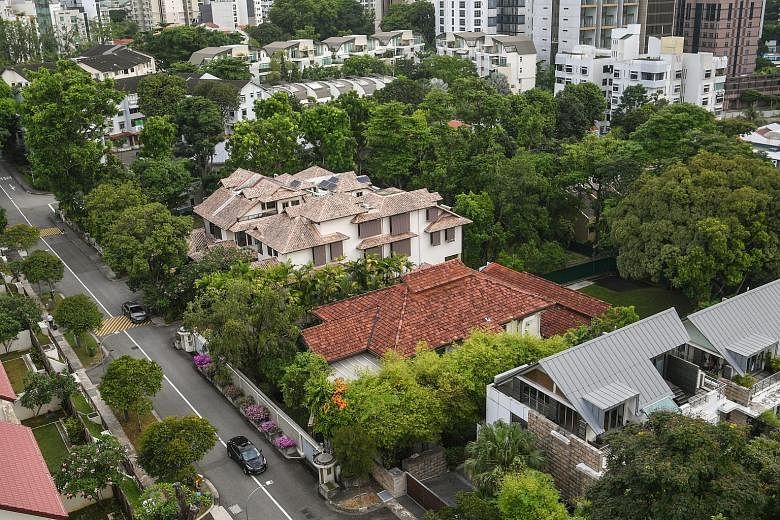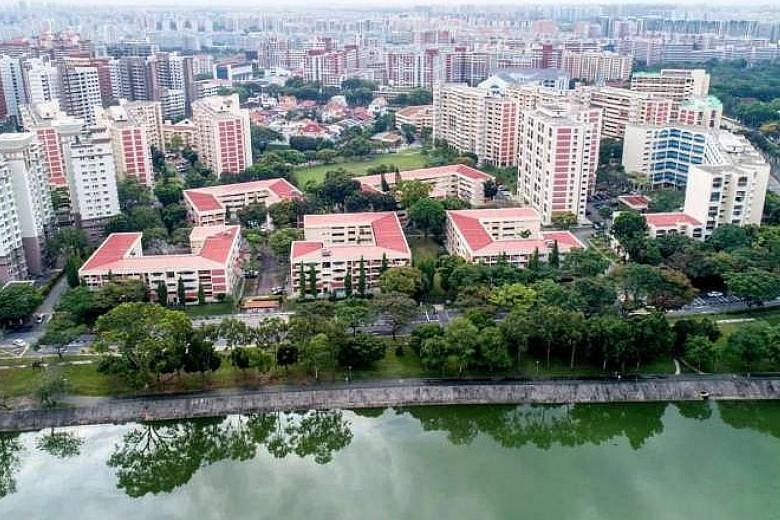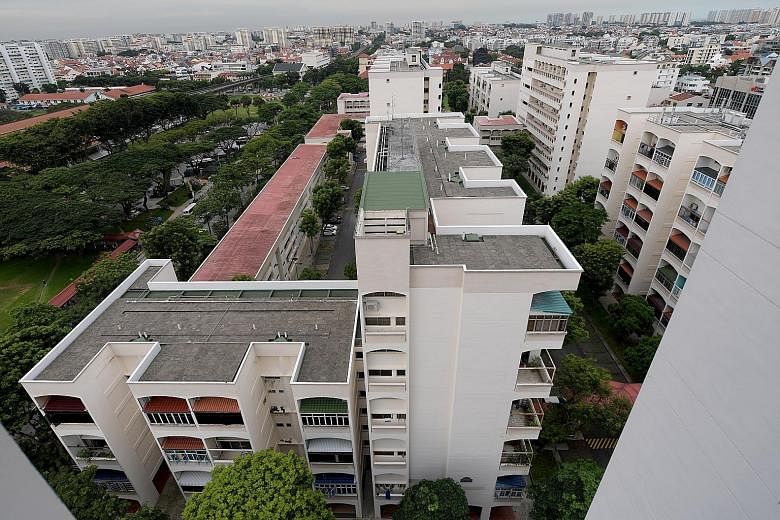If demolished and developed, 38, Oxley Road could transform into a swanky condominium with a trophy address - one its well-heeled residents could boast about.
But if it is kept, the residence of Singapore's first prime minister, Mr Lee Kuan Yew, will possess a value that goes beyond mere monetary concerns or the gratification of a select few, go other arguments.
The future of the two-storey bungalow has been the subject of a very public feud among Mr Lee's three children over the last two weeks.
In one camp are Dr Lee Wei Ling and Mr Lee Hsien Yang, who want the Government to commit to tearing down the house, according to their father's last wishes.
In the other is their brother, Prime Minister Lee Hsien Loong, who has argued that while his father wanted the house torn down, he also left open the possibility of preserving its history while keeping the public out of private areas within.
Government ministers have also come out several times to explain that the current government cannot bind a future one to a decision made today. No action needs to be taken until Dr Lee moves out of the house, which could be about 20 to 30 years down the road, they argue.

For now, the siblings are at an impasse, though tomorrow's Parliament sitting, in which PM Lee will address several issues, including the allegations of abuse of power his siblings have levelled against him, may well change things. The Sunday Times weighs the various options.
DEMOLITION, AND THEN WHAT?
At the heart of the matter is whether the house should be demolished. And if it is, should it be redeveloped or used as the site of an appropriate memorial park?
In an interview for the book Hard Truths To Keep Singapore Going, published in 2011, the late Mr Lee said he wanted the house gone after he died.
He said that the ageing house would be too costly to maintain, that left as a historical relic it would soon be in a shambles, and that the land value would go up once the 350m strip was allowed to be rezoned or have its plot ratio increased.

In online forums, many have accused the younger Lee sibling, Mr Lee Hsien Yang - who bought the house from his brother, Prime Minister Lee Hsien Loong, in 2015 at market value - of harbouring dreams to sell off the land to reap hundreds of millions of dollars. Mr Lee Hsien Yang staunchly denied such charges yesterday.
That there has been a resurgent market in the private property sector of late has only helped stoke such flames. There have been four collective sales this year - One Tree Hill Gardens, Goh & Goh Building and the former HUDC estates Rio Casa and Eunosville. Rio Casa in Hougang sold last month for $575 million. Eunosville in Sims Avenue went for $765 million in a deal finalised last month. Both were done above the owners' asking prices.
This could happen to 38, Oxley Road if the house is demolished to make way for redevelopment, one of several options Senior Minister of State for Finance and Law Indranee Rajah listed in a Facebook post on Monday.

Currently, the 1,120.5 sq m plot of freehold land on which the house sits - about the size of 12 four-room HDB flats - is worth about $24 million, according to media reports that take into consideration the per sq ft price of homes in the area.
But if the authorities allow the land to be rezoned or have its plot ratio increased - a possibility, since the previous concerns about Mr Lee's security, such as floor height, ceased when he died in 2015 - the returns would far outweigh the hefty price tag.
-
National monument: Factors to consider
-
The designation and protection of national monuments is administered by the National Heritage Board (NHB), which is guided by the Preservation of Monuments Act.
The legislation considers a wide range of factors including historical, cultural, archaeological, aesthetic and symbolic factors, as well as national significance.
The decision to gazette a building as a formal "national monument" is made with input from an advisory board of public- and private-sector members set up by NHB's Preservation of Sites and Monuments division, as well as from other government agencies and from discussions with the property owner.
If gazetted, a private residence is subject to compulsory acquisition under the Land Acquisition Act by the Government at market value within one year of the preservation order.
Several residential-type buildings have been gazetted as national monuments, such as Sun Yat Sen Nanyang Memorial Hall, Istana Kampong Glam and the former house of the late Teochew businessman Tan Yeok Nee, although none of those was a residence at the time of the gazetting.
A commercial property gazetted as a national monument - such as Raffles Hotel - need not be acquired by the Government. The NHB issues a set of preservation guidelines for the monument, which the owner has to follow.
Lin Yangchen
The tallest buildings in Oxley Road are two stacks of 12-storey apartments, called Orchard Court, at 19 and 27, Oxley Road.
If 38, Oxley Road can be rebuilt to become a condominium of at least 12 storeys and sold at $2,250 per sq ft - property experts cited $2,000 to $2,500 per sq ft as a reasonable price - developers are looking at a piece of land that could fetch about $140 million, after deducting construction and other costs.
And it would not be just this house that is affected. Neighbouring parcels of land may also follow suit, increasing the total land value.
"The spillover is significant. Oxley Road would be transformed," says National University of Singapore real estate associate professor Sing Tien Foo.
One person hoping for a collective sale is retired provision store owner K.S. Tham, 85, who lives in a three-bedroom apartment in the four-storey Oxley Mansion at 28, Oxley Road just down the street.
He was offered $2 million for his 1,000 sq ft apartment several years ago - a price he rejected as he believed it would be worth "at least 25 per cent more" if land use can be intensified.
Prof Sing adds: "The opportunity cost would be quite high not to allow more intense land development - if you're looking at it from a purely economic point of view."
He notes: "It's a low-density stretch of land in the city centre, and it's only natural to want to maximise land use."
But there is also historical value to the place whose basement was the birthplace of the People's Action Party.
"It's a matter of scarcity: 38, Oxley Road is one of a few places in Singapore with history in its walls, whereas there is a sufficient supply of homes at the moment," Prof Sing says.
"If we are at a point in time when we needed more apartments to sustain population growth, the trade-off to demolish No. 38 for more homes may be worth it.
"But there is no urgency to tear it down right now," he adds.
PRESERVATION OR CONSERVATION?
Another suggestion offered by Ms Indranee was to preserve the house by designating it a national monument subject to stringent guidelines from the National Heritage Board. Demolition and redevelopment would be definite nos.
There are cases for 38, Oxley Road's preservation that go beyond its political history.
Assistant Professor Yeo Kang Shua, an architectural historian at the Singapore University of Technology and Design, says: "The history of the house during Lee Kuan Yew's occupation is no doubt an important consideration.
"But we must also consider factors such as its history before Lee Kuan Yew's occupancy and the urban, social and economic contexts during the time of its construction."
The area where the house stands was named after a British surgeon, Thomas Oxley, who owned a nutmeg plantation there in the late 19th century.
The original owner of 38, Oxley Road, a Jewish merchant, had built house numbers 38 and 40 as a matching pair in the late 19th century. No. 40 has already been torn down and redeveloped.
The house is typical of bungalows of the time. It features low stilts that would typically leave the ground level open for ventilation to prevent damp and to rear livestock, but No. 38 has a "basement" room added by the original owner.
Architectural historians say not many houses like this remain, and it is rare to have an example like 38, Oxley Road whose interior has remained largely unmodified from its original state.
Experts also say it is premature to evaluate whether preserving only the "basement", as suggested in Ms Indranee's Facebook post, is a valid option from the perspective of heritage, as holistic evaluation first needs to be done for any structures being considered for preservation or conservation.
SOMETHING IN BETWEEN?
Indeed, it appears that the Government is seriously considering a middle ground: neither one that will leave 38, Oxley Road simply relegated to the history books , nor the house in its original form, open to public gawking.
As it stands, cars inevitably slow down as they drive past the house. The Sunday Times saw a group of 15 Indonesian tourists walking towards Orchard Road who stood opposite the house for a minute or two to attempt to catch a glimpse of its interior despite its intimidating gates and trees. Mr Lee is so intrinsically tied to modern Singapore that in death, his house continues to have some sort of pull.
Deputy Prime Minister Teo Chee Hean said last week that a ministerial committee he chairs to look into options for the house is considering demolishing the house, but keeping the basement dining room where many historical meetings took place, with an appropriate heritage centre attached.
Another idea is to have a memorial park built over the demolished house, an option Mr Lee Hsien Yang claimed to have suggested to Mr Teo.
Other Singaporeans have their own thoughts on how to treat 38, Oxley Road. Ms G. Uma Devi, managing director of local heritage consultancy Red Arrow Consulting, said people should look beyond the building and see the bigger picture.
"The whole nation - its transport, housing, education system - is a testament to the contributions of Lee Kuan Yew and his team. That's the thing that will outlast us and that's what we should take pride in.
"If we want to keep the building, we have to have constructive ideas on what to do with it," she adds.
For example, she asks whether there are significant stories that can be told within the house, or whether Mr Lee Kuan Yew might have had a favourite walking route in the neighbourhood.
"If we want to see his favourite items, we can always put them in places like the National Museum... We have to figure what it is about the house we are trying to hold on to."
She says that if the building is demolished, the site could be marked with a plaque to help future generations remember how the country's leaders tackled challenges in the past.
Plaques have already been used in Singapore to mark significant places and events such as the site of the National Theatre and of World War II battles.
Mr Wan Meng Hao, 47, a former executive secretary of the former Preservation of Monuments Board, cites the ubiquitous circular blue plaques attached to buildings in London, which state who lived in a particular place, with a brief explanation about their contributions to society. This could be done even if the original building is no longer standing, he adds.
These are but some of the options for the house. Will tomorrow's Parliament sitting shed any light on which path the Government will most likely choose? Some would say that it is unlikely it will tie itself down to a decision for now.



